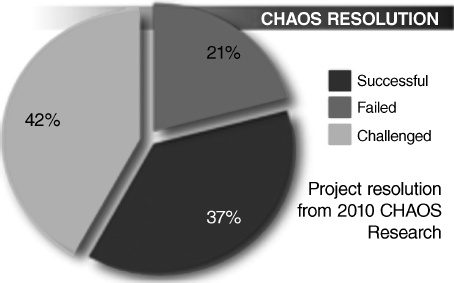Chapter 1
The Crisis in Software: The Wrong Process Produces the Wrong Results
Your organization—whether business, governmental, or nonprofit—likely needs to be able to create value by building, customizing, and using software. Without software, your ability to achieve your goals as a business leader is inherently limited, if not impossible. But despite this need, software development has historically been an unreliable, costly, error-prone endeavor.1 This leaves you in a pickle: You need software, but you can't get what you need, when you need it, at a cost that is acceptable, at a level of quality the makes it usable.
Indeed, the Standish Group's 2011 CHAOS Report found that more than half of software projects conducted between 2002 and 2010 were either described as challenged or complete failures; just 37 percent were classified as successful (Figure 1.1) The Standish Group modestly defined a successful project as delivering all the requested functionality, on the expected date, for the planned cost. The ability to accommodate changes, the ability to manage risks, or the inherent value of the software weren't considered.
Figure 1.1 Traditional Software Development Is Risky

The chances that a software project will be successful are not good. If you are trying to accomplish something critical that involves developing of software, you are probably worried. The software industry ...

